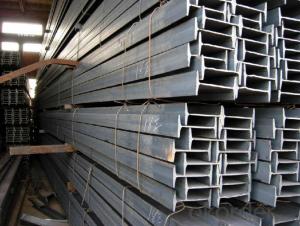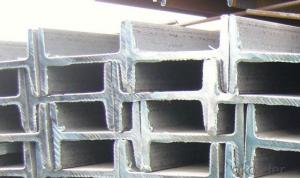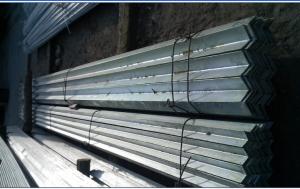IPEAA S235JR
- Loading Port:
- China Main Port
- Payment Terms:
- TT OR LC
- Min Order Qty:
- -
- Supply Capability:
- -
OKorder Service Pledge
OKorder Financial Service
You Might Also Like
Product Description:
IPEAA Beam Details:
| Minimum Order Quantity: | 10MT | Unit: | m.t. | Loading Port: | Tianjin Port, China |
| Supply Ability: | 10000MT | Payment Terms: | TT or LC | | |
Product Description:
Specifications of IPEAA Beam
1. Invoicing on theoretical weight or actual weight as customer request
2. Standard: EN10025, GB Standard, ASTM
3. Grade: Q235B, Q345B, SS400, ASTM A36, S235JR, S275JR
4. Length: 5.8M, 6M, 9M, 12M as following table
5. Sizes: 80mm-270mm
Dimensions(mm) | |||||
| h | b | s | t | Mass Kg/m |
IPEAA80 | 80 | 46 | 3.80 | 5.20 | 6.00 |
IPEAA100 | 100 | 55 | 4.10 | 5.70 | 8.10 |
IPEAA120 | 120 | 64 | 4.80 | 6.30 | 10.40 |
IPEAA140 | 140 | 73 | 4.70 | 6.90 | 12.90 |
IPEAA160 | 160 | 82 | 5.00 | 7.40 | 15.80 |
IPEAA180 | 180 | 91 | 5.30 | 8.00 | 18.80 |
IPEAA200 | 200 | 100 | 5.60 | 8.50 | 22.40 |
IPEAA220 | 220 | 110 | 5.90 | 9.20 | 26.20 |
IPEAA240 | 240 | 120 | 6.20 | 9.80 | 30.70 |
IPEAA270 | 270 | 135 | 6.60 | 10.20 | 36.10 |
Appications of IPEAA Beam
1. Supporting members, most commonly in the house raising industry to strengthen timber bears under houses. Transmission line towers, etc
2. Prefabricated structure
3. Medium scale bridges
4. It is widely used in various building structures and engineering structures such as roof beams, bridges, transmission towers, hoisting machinery and transport machinery, ships, industrial furnaces, reaction tower, container frame and warehouse etc.
Package & Delivery of IPEAA Beam
1. Packing: it is nude packed in bundles by steel wire rod
2. Bundle weight: not more than 3.5MT for bulk vessel; less than 3 MT for container load
3. Marks: Color marking: There will be color marking on both end of the bundle for the cargo delivered by bulk vessel. That makes it easily to distinguish at the destination port.
4. Tag mark: there will be tag mark tied up on the bundles. The information usually including supplier logo and name, product name, made in China, shipping marks and other information request by the customer.
If loading by container the marking is not needed, but we will prepare it as customer request.
5. Transportation: the goods are delivered by truck from mill to loading port, the maximum quantity can be loaded is around 40MTs by each truck. If the order quantity cannot reach the full truck loaded, the transportation cost per ton will be little higher than full load.
6. Delivery of IPE Beam: 30 days after getting L/C Original at sight or T/T in advance
Production flow of IPEAA Beam
Material prepare (billet) —heat up—rough rolling—precision rolling—cooling—packing—storage and transportation
- Q:Can Steel I-Beams be used for conveyor systems?
- Yes, steel I-beams can be used for conveyor systems. Steel I-beams are known for their high strength and durability, making them suitable for supporting heavy loads in conveyor applications. They provide excellent structural support and can withstand the constant movement and weight of conveyor belts and materials being transported. Additionally, steel I-beams can be easily customized to fit specific conveyor system requirements, such as length, width, and height. Their versatility and reliability make them a popular choice for conveyor systems across various industries.
- Q:Can steel I-beams be used for long-span bridges?
- Yes, steel I-beams can be used for long-span bridges. Steel I-beams are popular in bridge construction due to their high strength-to-weight ratio, durability, and versatility. They can support heavy loads while maintaining their structural integrity over long distances, making them suitable for long-span bridges. The I-beam's design, with its flanges providing additional strength and stiffness, allows for efficient distribution of loads and minimizes deflection. Additionally, steel I-beams can be fabricated in various sizes and shapes to accommodate different bridge designs and span lengths, making them a flexible choice for long-span bridge construction.
- Q:Are steel I-beams resistant to pests and insects?
- Pests and insects do not pose a threat to steel I-beams, unlike wood that can be easily destroyed by termites, ants, and other pests. Steel, being an inorganic material, does not serve as a food source for these creatures. As a result, steel I-beams exhibit exceptional resistance to infestation and damage caused by pests and insects. Consequently, steel structures are frequently employed in construction to minimize the possibility of pest-related problems that could undermine the stability of a building.
- Q:How do steel I-beams handle vibrations from nearby construction or demolition activities?
- Steel I-beams are well-known for their exceptional strength and durability, making them highly suitable for managing vibrations caused by nearby construction or demolition activities. The inherent rigidity and stiffness of steel I-beams enable them to effectively absorb and distribute vibrations, minimizing their impact on the supporting structure. When exposed to vibrations, steel I-beams function as a resilient framework, dispersing the energy throughout their length and transferring it to the surrounding structural elements. This process helps prevent excessive deflection or deformation of the beams, ensuring the overall stability and integrity of the structure. Additionally, the high mass and density of steel contribute to the absorption of vibrations. The weight of the I-beams aids in dampening the vibrations, reducing their amplitude and intensity. This characteristic is especially advantageous when dealing with low-frequency vibrations, as they have a greater potential to cause structural damage. Moreover, steel I-beams can be further enhanced to handle vibrations. Techniques such as incorporating dampening materials or isolating the beams from the surrounding structure can be employed to mitigate the effects of vibrations and improve their performance in this aspect. In conclusion, steel I-beams are highly effective in managing vibrations caused by nearby construction or demolition activities. Their strength, rigidity, and mass make them a robust choice for structural applications, ensuring that vibrations are efficiently controlled and pose minimal risk to the integrity of the building or infrastructure.
- Q:Can steel I-beams be used in multi-family residential buildings?
- Yes, steel I-beams can be used in multi-family residential buildings. Steel I-beams are commonly used in construction due to their strength and durability, making them suitable for supporting the weight of multiple floors and providing structural integrity in multi-family residential buildings. Moreover, steel I-beams offer design flexibility and can be easily integrated into various architectural styles.
- Q:Can steel I-beams be used in seismic retrofitting projects?
- Yes, steel I-beams can be used in seismic retrofitting projects. Steel I-beams are commonly utilized to strengthen and reinforce existing structures against seismic forces. Their strength and rigidity make them suitable for absorbing and distributing seismic energy, improving the overall structural integrity of the building.
- Q:Span 6 meters, with 160 I-beam can bear much weight?
- The subject is rough and can only be crudely assumed and crudely answered. Set to hot rolled Q235 material. The bending strength design value - 215N/mm.
- Q:What are the different types of steel coatings available for I-beams in renovations?
- There are several different types of steel coatings available for I-beams in renovations, including epoxy coatings, galvanized coatings, and powder coatings.
- Q:Are steel I-beams suitable for modular construction methods?
- Yes, steel I-beams are suitable for modular construction methods. Steel I-beams are widely used in modular construction due to their strength, durability, and versatility. They can effectively support heavy loads, making them ideal for constructing modular buildings that require structural stability. The I-shape design of these beams provides excellent resistance to bending and twisting forces, ensuring the overall stability of the modular structure. Moreover, the use of steel I-beams in modular construction allows for efficient and flexible building techniques. These beams can be easily prefabricated off-site and then transported to the construction site for assembly. This streamlined process reduces construction time and costs, making modular construction methods more cost-effective and time-efficient. Additionally, steel I-beams offer design flexibility in modular construction. They can be engineered to various sizes and lengths, allowing for customized building designs and configurations. This adaptability makes it easier to meet the specific requirements and design preferences of different modular projects. Furthermore, steel I-beams are highly resistant to fire, corrosion, and pests, ensuring long-term durability and minimal maintenance. This makes them suitable for modular buildings with high-quality standards and long lifespan expectations. In summary, steel I-beams are well-suited for modular construction methods. Their strength, durability, versatility, and ease of prefabrication make them an excellent choice for modular buildings, providing structural stability, cost-effectiveness, design flexibility, and long-term durability.
- Q:Are steel I-beams affected by temperature fluctuations?
- Temperature fluctuations do have an impact on steel I-beams. Steel, being a material, expands and contracts as the temperature changes. When subjected to high temperatures, like those in a fire, the steel I-beams expand and become weaker, affecting their structural integrity. In contrast, extremely cold temperatures cause the steel to contract, potentially resulting in problems like cracking or brittleness. Consequently, temperature fluctuations significantly influence the performance and stability of steel I-beams in different structures.
1. Manufacturer Overview |
|
|---|---|
| Location | |
| Year Established | |
| Annual Output Value | |
| Main Markets | |
| Company Certifications | |
2. Manufacturer Certificates |
|
|---|---|
| a) Certification Name | |
| Range | |
| Reference | |
| Validity Period | |
3. Manufacturer Capability |
|
|---|---|
| a)Trade Capacity | |
| Nearest Port | |
| Export Percentage | |
| No.of Employees in Trade Department | |
| Language Spoken: | |
| b)Factory Information | |
| Factory Size: | |
| No. of Production Lines | |
| Contract Manufacturing | |
| Product Price Range | |
Send your message to us
IPEAA S235JR
- Loading Port:
- China Main Port
- Payment Terms:
- TT OR LC
- Min Order Qty:
- -
- Supply Capability:
- -
OKorder Service Pledge
OKorder Financial Service
Similar products
New products
Hot products
Related keywords































